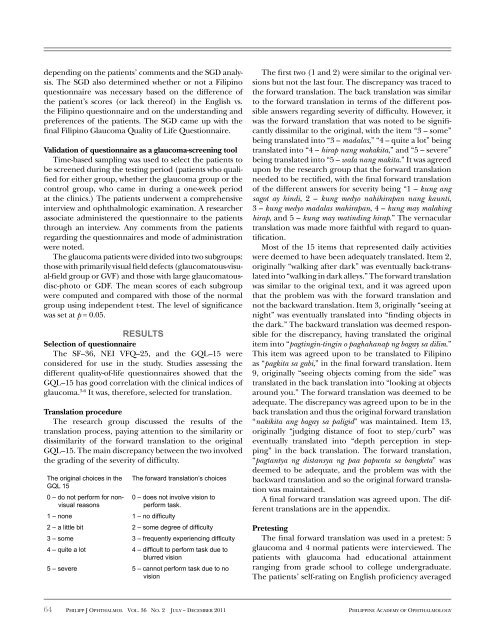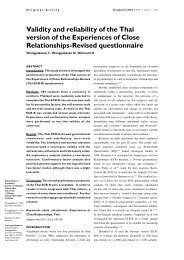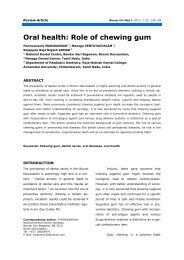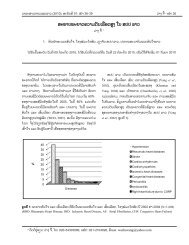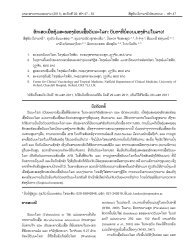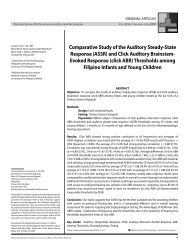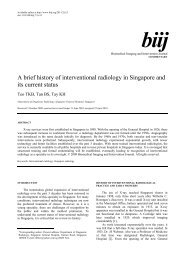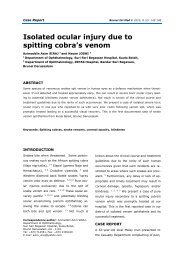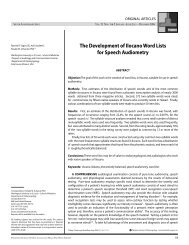depending on <strong>the</strong> patients’ comments <strong>and</strong> <strong>the</strong> SGD analysis.The SGD also determined whe<strong>the</strong>r or not a <strong>Filipino</strong>questionnaire was necessary based on <strong>the</strong> difference <strong>of</strong><strong>the</strong> patient’s scores (or lack <strong>the</strong>re<strong>of</strong>) in <strong>the</strong> English vs.<strong>the</strong> <strong>Filipino</strong> questionnaire <strong>and</strong> on <strong>the</strong> underst<strong>and</strong>ing <strong>and</strong>preferences <strong>of</strong> <strong>the</strong> patients. The SGD came up with <strong>the</strong>final <strong>Filipino</strong> Glaucoma Quality <strong>of</strong> Life Questionnaire.Validation <strong>of</strong> questionnaire as a <strong>glaucoma</strong>-screening toolTime-based sampling was used to select <strong>the</strong> patients tobe screened during <strong>the</strong> testing period (patients who qualifiedfor ei<strong>the</strong>r group, whe<strong>the</strong>r <strong>the</strong> <strong>glaucoma</strong> group or <strong>the</strong>control group, who came in during a one-week periodat <strong>the</strong> clinics.) The patients underwent a comprehensiveinterview <strong>and</strong> ophthalmologic examination. A researcherassociate administered <strong>the</strong> questionnaire to <strong>the</strong> patientsthrough an interview. Any comments from <strong>the</strong> patientsregarding <strong>the</strong> questionnaires <strong>and</strong> mode <strong>of</strong> administrationwere noted.The <strong>glaucoma</strong> patients were divided into two subgroups:those with primarily visual field defects (<strong>glaucoma</strong>tous-visual-fieldgroup or GVF) <strong>and</strong> those with large <strong>glaucoma</strong>tousdisc-photoor GDF. The mean scores <strong>of</strong> each subgroupwere computed <strong>and</strong> compared with those <strong>of</strong> <strong>the</strong> normalgroup using independent t-test. The level <strong>of</strong> significancewas set at p = 0.05.RESULTSSelection <strong>of</strong> questionnaireThe SF–36, NEI VFQ–25, <strong>and</strong> <strong>the</strong> GQL–15 wereconsidered for use in <strong>the</strong> study. Studies assessing <strong>the</strong>different quality-<strong>of</strong>-life questionnaires showed that <strong>the</strong>GQL–15 has good correlation with <strong>the</strong> clinical indices <strong>of</strong><strong>glaucoma</strong>. 3-6 It was, <strong>the</strong>refore, selected for translation.<strong>Translation</strong> procedureThe research group discussed <strong>the</strong> results <strong>of</strong> <strong>the</strong>translation process, paying attention to <strong>the</strong> similarity ordissimilarity <strong>of</strong> <strong>the</strong> forward translation to <strong>the</strong> originalGQL–15. The main discrepancy between <strong>the</strong> two involved<strong>the</strong> grading <strong>of</strong> <strong>the</strong> severity <strong>of</strong> difficulty.The original choices in <strong>the</strong>GQL 150 – do not perform for nonvisualreasonsThe forward translation’s choices0 – does not involve vision toperform task.1 – none 1 – no difficulty2 – a little bit 2 – some degree <strong>of</strong> difficulty3 – some 3 – frequently experiencing difficulty4 – quite a lot 4 – difficult to perform task due toblurred vision5 – severe 5 – cannot perform task due to novisionThe first two (1 <strong>and</strong> 2) were similar to <strong>the</strong> original <strong>version</strong>sbut not <strong>the</strong> last four. The discrepancy was traced to<strong>the</strong> forward translation. The back translation was similarto <strong>the</strong> forward translation in terms <strong>of</strong> <strong>the</strong> different possibleanswers regarding severity <strong>of</strong> difficulty. However, itwas <strong>the</strong> forward translation that was noted to be significantlydissimilar to <strong>the</strong> original, with <strong>the</strong> item “3 – some”being translated into “3 – madalas,” “4 – quite a lot” beingtranslated into “4 – hirap nang makakita,” <strong>and</strong> “5 – severe”being translated into “5 – wala nang makita.” It was agreedupon by <strong>the</strong> research group that <strong>the</strong> forward translationneeded to be rectified, with <strong>the</strong> final forward translation<strong>of</strong> <strong>the</strong> different answers for severity being “1 – kung angsagot ay hindi, 2 – kung medyo nahihirapan nang kaunti,3 – kung medyo madalas mahirapan, 4 – kung may malakinghirap, <strong>and</strong> 5 – kung may matinding hirap.” The vernaculartranslation was made more faithful with regard to quantification.Most <strong>of</strong> <strong>the</strong> 15 items that represented daily activitieswere deemed to have been adequately translated. Item 2,originally “walking after dark” was eventually back-translatedinto “walking in dark alleys.” The forward translationwas similar to <strong>the</strong> original text, <strong>and</strong> it was agreed uponthat <strong>the</strong> problem was with <strong>the</strong> forward translation <strong>and</strong>not <strong>the</strong> backward translation. Item 3, originally “seeing atnight” was eventually translated into “finding objects in<strong>the</strong> dark.” The backward translation was deemed responsiblefor <strong>the</strong> discrepancy, having translated <strong>the</strong> originalitem into “pagtingin-tingin o paghahanap ng bagay sa dilim.”This item was agreed upon to be translated to <strong>Filipino</strong>as “pagkita sa gabi,” in <strong>the</strong> final forward translation. Item9, originally “seeing objects coming from <strong>the</strong> side” wastranslated in <strong>the</strong> back translation into “looking at objectsaround you.” The forward translation was deemed to beadequate. The discrepancy was agreed upon to be in <strong>the</strong>back translation <strong>and</strong> thus <strong>the</strong> original forward translation“nakikita ang bagay sa paligid” was maintained. Item 13,originally “judging distance <strong>of</strong> foot to step/curb” waseventually translated into “depth perception in stepping”in <strong>the</strong> back translation. The forward translation,“pagtantya ng distansya ng paa papunta sa bangketa” wasdeemed to be adequate, <strong>and</strong> <strong>the</strong> problem was with <strong>the</strong>backward translation <strong>and</strong> so <strong>the</strong> original forward translationwas maintained.A final forward translation was agreed upon. The differenttranslations are in <strong>the</strong> appendix.PretestingThe final forward translation was used in a pretest: 5<strong>glaucoma</strong> <strong>and</strong> 4 normal patients were interviewed. Thepatients with <strong>glaucoma</strong> had educational attainmentranging from grade school to college undergraduate.The patients’ self-rating on English pr<strong>of</strong>iciency averaged64 Philipp J Ophthalmol Vol. 36 No. 2 July – December 2011Philippine Academy <strong>of</strong> Ophthalmology
4.6, with <strong>the</strong> lowest score 2, <strong>and</strong> <strong>the</strong> highest score 8. Thepatients’ self-rating on <strong>Filipino</strong> pr<strong>of</strong>iciency averaged9, with <strong>the</strong> lowest score 7 <strong>and</strong> <strong>the</strong> highest score 10 (3patients). There was a difference in <strong>the</strong> average scores <strong>of</strong><strong>the</strong> English <strong>and</strong> <strong>Filipino</strong> questionnaires <strong>of</strong> 4.4, <strong>the</strong> lowest2 <strong>and</strong> <strong>the</strong> highest 8. The absolute value <strong>of</strong> <strong>the</strong> difference<strong>of</strong> <strong>the</strong> scores per item was also totaled, with an average<strong>of</strong> 15. The biggest absolute value difference between <strong>the</strong>two scores was 31. There were also scores with small differences<strong>of</strong> between 2 <strong>and</strong> 9.The control population had educational attainmentranging from grade school to high school. They had anaverage rating for English pr<strong>of</strong>iciency <strong>of</strong> 6.25 with <strong>the</strong>highest score 8 <strong>and</strong> <strong>the</strong> lowest 5. They had an average<strong>Filipino</strong> pr<strong>of</strong>iciency <strong>of</strong> 9, with <strong>the</strong> lowest 8 <strong>and</strong> <strong>the</strong> highest10. The average difference in scores was 7.25. The averagedifference in <strong>the</strong> absolute values <strong>of</strong> <strong>the</strong> differences inscores per item was 7.75.All in all, 6 out <strong>of</strong> 9 patients had a self-pr<strong>of</strong>iciencyrating in English at least 5 points lower than in <strong>Filipino</strong>.Three <strong>of</strong> <strong>the</strong>se patients were responsible for <strong>the</strong> scoresthat had a large difference in <strong>the</strong> sum <strong>of</strong> absolute values<strong>of</strong> differences in scores per item. The average self-ratingwas 5.3/10 in English pr<strong>of</strong>iciency <strong>and</strong> 9/10 <strong>Filipino</strong>pr<strong>of</strong>iciency. Seven out <strong>of</strong> /9 commented that <strong>the</strong>y found<strong>the</strong> <strong>Filipino</strong> questionnaire easier to underst<strong>and</strong> <strong>and</strong>answer compared to <strong>the</strong> English questionnaire, with <strong>the</strong>rest commenting <strong>the</strong> opposite. None <strong>of</strong> <strong>the</strong> respondentsfound <strong>the</strong> need for additional questions.Small-group discussionThe results <strong>of</strong> <strong>the</strong> pretest were discussed by <strong>the</strong> researchgroup along with an expert. It was deemed that althoughnot all participants had a large difference in <strong>the</strong> scoresobtained from using <strong>the</strong> English vs. <strong>the</strong> <strong>Filipino</strong> questionnaire,<strong>the</strong> presence <strong>of</strong> individuals with large differences<strong>of</strong> answers <strong>of</strong> <strong>the</strong> English vs. <strong>the</strong> <strong>Filipino</strong> questionnairewas enough reason to have a <strong>Filipino</strong> questionnaire. Thiswas validated by <strong>the</strong> preference <strong>of</strong> all but 2 patients toanswer <strong>the</strong> <strong>Filipino</strong> questionnaire. Based on <strong>the</strong> results <strong>of</strong><strong>the</strong> pretest, none <strong>of</strong> <strong>the</strong> items in <strong>the</strong> translated questionnairewere modified <strong>and</strong> no items were added. It was aagreed upon that <strong>the</strong>re was enough reason warrant <strong>the</strong>need for <strong>the</strong> use <strong>of</strong> a <strong>Filipino</strong> <strong>version</strong> <strong>of</strong> <strong>the</strong> GQL–15, <strong>and</strong>that <strong>the</strong> final forward translation <strong>of</strong> <strong>the</strong> questionnairecould be used as is.ValidationThe final forward translation was administered topatients fulfilling <strong>the</strong> inclusion criteria. Time-basedsampling (1 week or 5 clinic days) was used. A total <strong>of</strong>13 patients with <strong>glaucoma</strong>tous-visual-field findings <strong>and</strong> 8patients with <strong>glaucoma</strong>tous-disc-photo findings qualifiedfor <strong>the</strong> study. The scores <strong>of</strong> patients with <strong>glaucoma</strong>tousvisual fields ranged from 16 to 64, with an average <strong>of</strong>34.15/75. The scores <strong>of</strong> patients with <strong>glaucoma</strong>tous-discphot<strong>of</strong>indings ranged from 23 to 62, with an average <strong>of</strong>34.5/75 (Table 1). The final forward translation was alsoadministered to normal population composed <strong>of</strong> 16 patients.Their scores ranged from 15 to 21, with an averagescore <strong>of</strong> 16.81 (Table 1).The average score <strong>of</strong> <strong>the</strong> group with <strong>glaucoma</strong>tousvisual-fieldfindings was compared to <strong>the</strong> average score<strong>of</strong> <strong>the</strong> control group using an independent t-test. Thenull hypo<strong>the</strong>ses were <strong>the</strong>re was no significant differencebetween <strong>the</strong> groups with <strong>glaucoma</strong> <strong>and</strong> <strong>the</strong> normal/control group. The computed t-value <strong>of</strong> <strong>the</strong> group with<strong>glaucoma</strong>tous visual fields was 2.66. The computed t-value<strong>of</strong> <strong>the</strong> group with <strong>glaucoma</strong>tous disc photos was 2.54.With a p value <strong>of</strong> 0.05, it was noted that <strong>the</strong> t values <strong>of</strong> <strong>the</strong><strong>glaucoma</strong>tous visual field group <strong>and</strong> <strong>the</strong> <strong>glaucoma</strong>tousoptic disc group were higher than <strong>the</strong> t-values for <strong>the</strong>irrespective degrees <strong>of</strong> freedom based on sample size. Bothnull hypo<strong>the</strong>ses were rejected <strong>and</strong> <strong>the</strong> alternative hypo<strong>the</strong>seswere accepted. There was a significant differencebetween <strong>the</strong> group with <strong>glaucoma</strong>tous visual fields <strong>and</strong><strong>the</strong> normal/control group. There was also a significantdifference between <strong>the</strong> group with <strong>glaucoma</strong>tous discphotos <strong>and</strong> <strong>the</strong> normal/control group.DISCUSSIONThe GQL–15 was chosen since it was shown to havegood correlation with clinical indices <strong>of</strong> <strong>glaucoma</strong>. Itshould be noted that <strong>the</strong> GQL–15 is just a vision-relatedquality-<strong>of</strong>-life questionnaire. The o<strong>the</strong>r vision-relatedquality-<strong>of</strong>-life questionnaires were not disease-specific.The GQL–15 includes questions on central <strong>and</strong> nearvision (questions 1, 14 <strong>and</strong> 15), peripheral vision (questions8, 9, 11, 12), dark adaptation <strong>and</strong> glare (questions2, 3, 5, 6 <strong>and</strong> 7), personal care (14) <strong>and</strong> outdoor mobility(questions 4, 10 <strong>and</strong> 13).The translation procedure was straightforward, with<strong>the</strong> two translators producing <strong>the</strong> required output. Itwas noted during evaluation <strong>of</strong> <strong>the</strong> translations that <strong>the</strong>most difficult part for both translators was translating <strong>the</strong>scale <strong>of</strong> <strong>the</strong> answers to <strong>the</strong> questionnaire, as described in<strong>the</strong> results. The research group carefully reconciled <strong>the</strong>differences between <strong>the</strong> two translations <strong>and</strong> compared<strong>the</strong>m to <strong>the</strong> original questionnaire to produce <strong>the</strong> finaltranslation. The difficulty in translation was attributed to<strong>the</strong> lack <strong>of</strong> a definite translation in <strong>Filipino</strong> <strong>of</strong> <strong>the</strong> Englishscale used in <strong>the</strong> original GQL–15 Questionnaire. Therest <strong>of</strong> <strong>the</strong> discrepancies as discussed in <strong>the</strong> results wereagreed upon to be minor differences, with <strong>the</strong> discrepanciesrectified in <strong>the</strong> final forward translation.The results <strong>of</strong> <strong>the</strong> pretest convinced <strong>the</strong> membersPhilippine Academy <strong>of</strong> Ophthalmology Philipp J Ophthalmol Vol. 36 No. 2 July – December 201165


